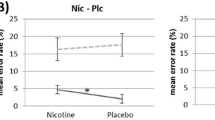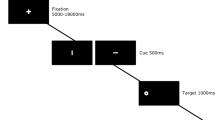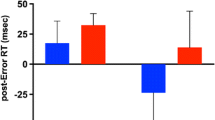Abstract
Introduction
The antisaccade task provides a powerful tool with which to investigate the cognitive and neural systems underlying goal-directed behaviour, particularly in situations when the correct behavioural response requires the suppression of a prepotent response. Antisaccade errors (failures to suppress reflexive prosaccades towards sudden-onset targets) are increased in patients with damage to the dorsolateral prefrontal cortex, and in patients with schizophrenia. Nicotine has been found to improve antisaccade performance in patients with schizophrenia and healthy controls. This performance enhancing effect may be due to direct effects on the cholinergic system, but there has been no test of this hypothesis.
Materials and methods
In a double blind, double dummy, placebo-controlled design, we compared the effect of nicotine and modafinil, a putative indirect noradrenergic agonist, on antisaccade performance in healthy non-smokers.
Results and discussion
Both compounds reduced latency for correct antisaccades, although neither reduced antisaccade errors. These findings are discussed with reference to the pharmacological route of performance enhancement on the antisaccade task and current models of antisaccade performance.



Similar content being viewed by others
Notes
Nasal spray administration has been shown to reach peak plasma concentration more rapidly than oral or transdermal patch preparations. In one study peak serum nicotine concentration of 4.71 +/− 3.16 ng/ml occurred 10 min after administration of 3 mg of nicotine via nasal spray (Fishbein et al. 2000)
We note a potential confound on this physiological measure with meal-related changes (lunch was given to all participants 3 1/2 hours post baseline) that widen the pulse pressure (diastolic–systolic gap) through a reduction in total resistance (De Mey et al. 1993)
References
Andersson K, Hockey GRJ (1977) Effects of cigarette smoking on incidental memory. Psychopharmacology 52:223–226
Baranski JV, Pigeau R, Dinich P, Jacobs I (2004) Effects of modafinil on cognitive and metacognitive performance. Hum Psychopharmacol 19:323–332
Ballon JS, Feifel D (2006) A systematic review of modafinil: Potential clinical uses and mechanisms of action. J Clin Psychiatry 67:554–566
Barrett SL, Bell R, Watson D, King DG (2004) Effects of amisulpride, risperidone and chlorpromazine on auditory and visual latent inhibition, prepulse inhibition, executive function and eye movements in healthy volunteers. J Psychopharmacol 18:156–172
Berridge CW, Waterhouse BF (2003) the locus coeruleus–noradrenergic system: modulation of behavioural state and state-dependent cognitive processes. Brains Res Rev 42:33–84
Caldwell JA Jr, Caldwell JL, Smythe NK III, Hall KK (2000) A double-blind, placebo controlled investigation of the efficacy of modafinil for sustaining the alertness and performance of aviators: a helicopter simulator study. Psychopharmacology 150:72–282
Chamberlain SR, Muller U, Blackwell AD, Robbins TW, Sahakian BJ (2006) Noradrenergic modulation of working memory and emotional memory in humans. Psychopharmacology 188:397–407
Chudasama Y, Robbins TW (2006) Functions of frontostriatal systems in cognition: comparative neuropsychological studies in rats, monkeys and humans. Biol Psychol 73:19–38
Clarke PBS, Reuben M (1996) Release of [3H]-noradrenalin from rat hippocampal synaptosomes by nicotine: mediation by different nicotinic receptor subtypes from striatal [3H]-dopamine release. Br J Pharmacol 117:595–606
Corrigall WA, Coen KM, Adamson L (1994) Self-administered nicotine activates the mesolimbic dopamine system through the ventral tegmental area. Brain Res 653:278–284
De Mey C, Enterling D, Meineke I (1993) Cardiovascular effects of eating, atenolol and their interaction: beta-1 adrenergic modulation does not play a predominant role in the genesis of postprandial effects. Br J Clin Pharmacol 36:427–435
De Séréville JE, Boer C, Rambert FA, Duteil J (1994) Lack of presynaptic dopaminergic involvement in modafinil activity in anesthetized mice—in-vivo voltammetry studies. Neuropharmacology 33:755–761
Depatie L, O’Driscoll GA, Holahan AV, Atkinson V, Thavundayil JX, Kin NNY, Lal S (2002) Nicotine and behavioural markers of risk for schizophrenia: a double-blind, placebo-controlled, cross-over study. Neuropsychopharmacology 27:1056–1070
Duka T, Lupp A (1997) The effects of incentive on antisaccades; is a dopaminergic mechanism involved? Behav Pharmacol 8:373–382
Dursun SM, Wright N, Reveley MA (1999) Effects of amphetamine on saccadic eye movements in man: possible relevance to schizophrenia? J Psychopharmacol 13:245–247
Duteil J, Rambert FA, Pessonnier J, Hermant JF, Gombert R, Assous E (1990) Central alpha1-adrenergic stimulation in relation to the behaviour stimulating effect of modafinil; studies with experimental animals. Eur J Pharmacol 180:49–58
Dyckman KA, McDowell JE (2005) Behavioral plasticity of antisaccade performance following daily practice. Exp Brain Res 162:63–69
Engber TM, Dennis SA, Jones BE, Miller MS, Contreras PC (1998) Brain regional substrates for the actions of the novel wake-promoting agent modafinil in the rat: comparison with amphetamine. Neuroscience 87:905–911
Ettinger U, Kumari V, Crawford TJ, Davis RE, Sharma T, Corr PJ (2003) Reliability of smooth pursuit, fixation, and saccadic eye movements. Psychophysiology 40:620–628
Ferraro L, Tanganelli S, O’Connor TW, Antonelli T, Rambert R, Fuxe K (1996) The vigilance promoting drug modafinil decreases GABA release in the medial preoptic area and in the posterior hypothalamus of the awake rat: possible involvement of the serotonergic 5-HT3 receptor. Neurosci Lett 220:5–8
Fischer B, Weber H (1992) Characteristics of "anti" saccades in man. Exp Brain Res 89:415–424
Foulds J, Stapleton J, Swettenham J, Bell N, McSorley K, Russell MAH (1996) Cognitive performance effects of subcutaneous nicotine in smokers and never-smokers. Psychopharmacology 127:31–38
Gaymard B, Ploner CJ, Rivaud-Pechoux S, Pierrot-Deseilligny C (1999) The frontal eye field is involved in spatial short-term memory but not in reflexive saccade inhibition. Exp Brain Res 129:288–301
Green JF, King DJ, Trimble KM (2000) Antisaccade and smooth pursuit eye movements in healthy subjects receiving sertraline and lorazepam. J Psychopharmacol 14:30–36
Hallett PE (1978) Primary and secondary saccades to goals defined by instructions. Vis Res 18:1279–1296
Hermant JF, Rambert FA, Duteil J (1991) Awakening properties of modafinil—effect on nocturnal activity in monkeys (macaca-mulatta) after acute and repeated administration. Psychopharmacology 103:28–32
Hurt RD, Offord KP, Croghan IT, Crohgan GA, Gomez-Dahl LC, Wolter TD, Dale LC, Moyer TP (1998) Temporal effects of nicotine nasal spray and gum on nicotine withdrawal symptoms. Psychopharmacology 140:98–104
Hutton SB, Ettinger U (2006) The antisaccade task as a research tool in psychopathology: a critical review. Psychophysiology 43:302–313
Hutton SB, Crawford TJ, Puri BK, Duncan LJ, Chapman M, Kennard C, Barnes TR, Joyce EM (1998) Smooth pursuit and saccadic abnormalities in first-episode schizophrenia. Psychol Med 28:685–692
Hutton SB, Joyce EM, Barnes TRE, Kennard C (2002) Saccadic distractibility in first-episode schizophrenia. Neuropsychologia 40:1729–1736
James W (1890) The principles of psychology. Holt, New York
Jakala P, Riekkinen M, Sirvio J, Koivisto E, Riekkinen P (1999) Clonidine, but not guanfacine, impairs choice reaction time in young healthy volunteers. Neuropsychopharmacology 21:495–502
Khan SA, Ford K, Timney B, Everling S (2003) Effects of ethanol on anti-saccade task performance. Exp Brain Res 150:68–74
Knott VJ, Raegele M, Fisher D, Robertson N, Millar A, McIntosh J, Ilivitsky V (2005) Clonidine pre-treatment fails to block acute smoking-induced EEG arousal/mood in cigarette smokers. Pharmacol Biochem Behav 80:161–171
Kumari V, Postma P (2005) Nicotine use in schizophrenia: the self medication hypothesis. Neurosci Biobehav Rev 29:1021–1034
Larrison-Faucher AL, Briand KA, Sereno AB (2004a) Nicotine improves antisaccade task performance without affecting prosaccades. Human Psychopharmacol 19:409–419
Larrison-Faucher AL, Matorin AA, Sereno AB (2004b) Nicotine reduces antisaccade errors in task impaired subjects. Prog Neuro-psychopharmacol Biol Psychiatry 28:505–516
Lin JS, Roussel b, Akaoka H, Fort P, Debilly G, Jouvet M (1992) Role of catecholamines in modafinil and amphetamine induced wakefulness, a comparative pharmacological study in the cat. Brain Res 591:319–326
Massen C (2004) Parallel programming of exogenous and endogenous components in the antisaccade task. Q J Exp Psychol 57A:475–498
McNair DM, Lorr M, Droppleman LF (1971) Manual for the Profile of Mood States. Educational and Industrial Testing Service, San Diego, CA
Moachon G, Kanmacher I, Clenet M, Matinier D (1996) Pharmacokinetic profile of modafinil. Med Actual 32:23–33
Müller U, Steffenhagen N, Regenthal R, Bublak P (2004) Effects of modafinil on working memory processes in humans. Psychopharmacology 177:161–169
Munoz DP, Everling S (2004) Look away: the antisaccade task and the voluntary control of eye movement. Nat Rev Neurosci 5:218–228
Norman DA (1981) Categorization of action slips. Psychol Rev 88:1–15
Pierrot-Deseilligny C, Muri RM, Nyffeler T, Milea D (2005) The role of the human dorsolateral prefrontal cortex in ocular motor behavior. Ann NY Acad Sci 1039:232–238
Powell J, Dawkins L, Davis RE (2002) Smoking, reward responsiveness and response inhibition: tests of an incentive motivational model. Biol Psychiatry 51:151–163
Rambert FA, Pessonnier J, Duteil J (1990) Modafinilphenidate, amphetaminephenidate and methylphenidate-induced hyperactivities in mice involve different mechanisms. Eur J Pharmacol 183:455–456
Randall DC, Fleck NL, Shneerson JM, File SE (2004) The cognitive-enhancing properties of modafinil are limited in non-sleep deprived middle-aged volunteers. Pharmacol Biochem Behav 77:547–555
Randall DC, Viswanath A, Bharania P, Elsabagh SM, Hartley DE, Shneerson JM, File SE (2005) Does modafinil enhance cognitive performance in young volunteers who are not sleep-deprived? J Clin Psychopharmacol 25:175–179
Reason J (1984) The psychopathology of everyday slips—accidents happen when habit goes haywire. Sciences (New York) 24:44–49
Robbins TW (2002) The 5-choice serial reaction time task: behavioural pharmacology and functional neurochemistry. Psychopharmacology 163:362–380
Rycroft N, Rusted JM, Hutton SB (2006) The antisaccade task as an index of sustained goal activation in working memory: modulation by nicotine. Psychopharmacology 188:521–529
Sarter M, Hasselmoe ME, Bruno JP, Givens B (2005) Unravelling the attentional functions of cortical cholinergic inputs: interactions between signal-driven and cognitive modulation of signal detection. Brains Res Rev 48:98–111
Scammell TE, Estabrooke IV, McCarthy MT, Chemelli RM, Yanagisawa M, Miller MS, Saper CB (2000) Hypothalamic arousal regions are activated during modafinil-induced wakefulness. J Neurosci 20:8620–8628
Smyrnis N, Evdokimidis I, Stefanis NC, Constantinidis TS, Avramopoulos D, Theleritis C, Paximadis C, Efstratiadis C, Kastrinakis G, Stefanis CN (2002) The antisaccade task in a sample of 2,006 young males. II Effects of task parameters. Exp Brain Res 147:53–63
Stivalet P, Esquivie D, Barraud PA, Leifflen D, Raphel C (1998) Effects of modafinil on attentional processes during 60 hours of sleep deprivation. Hum Psychopharmacol 13:501–507
Turner DC, Robbins TW, Clark L, Aron AR, Dowson J, Sahakian BJ (2003) Cognitive enhancing effects of modafinil in healthy volunteers. Psychopharmacology 165:260–269
Watkins SS, Stinus L, Koob GF, Markou A (2000) Reward and somatic changes during precipitated nicotine withdrawal in rats: centrally and peripherally mediated effects. J Pharmacol Exp Ther 292:1053–1064
Wesensten NJ, Belenky G, Kautz MA, Thorne DR, Reichardt RM, Balkin TJ (2002) Maintaining alertness and performance during sleep deprivation: modafinil versus caffeine. Psychopharmacology 159:238–247
Williams GV, Goldman-Rakic PS (1995) Modulation of memory fields by dopamine D1 recpetors in prefrontal cortex. Nature 376:572–575
Wisor JP, Eriksson KS (2005) Dopaminergic-adrenergic interactions in the wake promoting mechanism of modafinil. Neuroscience 132:1027–1034
Wong YN, King P, Laughton WB, McCormick GC, Grebow PE (1998) Single-dose pharmacokinetics of modafinil and methylphenidate given alone or in combination in healthy male volunteers. J Clin Psychopharmacol 38:276–282
Acknowledgements
This work was supported by a BBSRC D. Phil studentship to the first author. We thank McNeil AB, Helsingborg, Sweden, for providing the nicotine nasal sprays and matched placebo sprays.
Author information
Authors and Affiliations
Corresponding author
Rights and permissions
About this article
Cite this article
Rycroft, N., Hutton, S.B., Clowry, O. et al. Non-cholinergic modulation of antisaccade performance: a modafinil-nicotine comparison. Psychopharmacology 195, 245–253 (2007). https://doi.org/10.1007/s00213-007-0885-x
Received:
Accepted:
Published:
Issue Date:
DOI: https://doi.org/10.1007/s00213-007-0885-x




